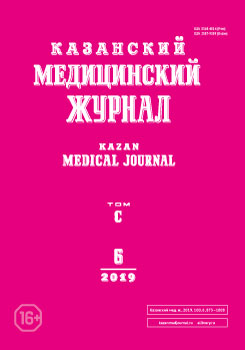“Global” assays of hemostasis in modern obstetrical practice
- Authors: Mustafin IG1, Kurmanbaev TE2, Shmidt AA2, Timoshkova Y.L2, Atayants KM2
-
Affiliations:
- Kazan State Medical University
- S.M. Kirov Military Medical Academy
- Issue: Vol 100, No 6 (2019)
- Pages: 958-964
- Section: Reviews
- URL: https://bakhtiniada.ru/kazanmedj/article/view/18517
- DOI: https://doi.org/10.17816/KMJ2019-958
- ID: 18517
Cite item
Full Text
Abstract
It is known that during pregnancy, the hemostatic system, like the rest of the body's systems, undergoes certain changes: there is a gradual increase in the activity of coagulation unit of the hemostasis reaching a maximum before childbirth. However, if pregnancy is complicated by various hypertensive conditions, such as preeclampsia, an imbalance is observed in the hemostasis: against the background of an increase in the activity of coagulation link, depletion of anticoagulation factors and dysfunction of fibrinolytic system are observed. All these changes create a pathogenetic basis for the occurrence of severe thrombohemorrhagic complications that are fatal for both mother and fetus. Thus, the timely detection of these violations is an important task for modern obstetrics. Unfortunately, the applied screening methods for assessing the hemostasis system in practice provide extremely limited information: the tests have low sensitivity to hypercoagulation, as well as moderate to hypocoagulation, they do not allow to fully evaluate the dynamics of coagulation process in real time. In addition, when performing the same tests with reagents of different companies in the same patient, there may be a significant difference in the results. Disadvantages of screening tests became the reason for the search for a test to assess the functioning of the hemostatic system, which can reflect the complete picture of the state of blood coagulation system, and not of its individual links. Such tests are the so-called “global” tests for assessing the hemostatic system: thrombin generation test, thromboelastography, low-frequency piezothromboelastography and thrombodynamics. Each of the listed “global” tests has been successfully tested in obstetric and gynecological practice.
Full Text
##article.viewOnOriginalSite##About the authors
I G Mustafin
Kazan State Medical University
Email: timka_rus@inbox.ru
SPIN-code: 1588-6988
Russian Federation, Kazan, Russia
T E Kurmanbaev
S.M. Kirov Military Medical Academy
Author for correspondence.
Email: timka_rus@inbox.ru
SPIN-code: 7818-6181
Russian Federation, Saint Petersburg, Russia
A A Shmidt
S.M. Kirov Military Medical Academy
Email: timka_rus@inbox.ru
Russian Federation, Saint Petersburg, Russia
Yu L Timoshkova
S.M. Kirov Military Medical Academy
Email: timka_rus@inbox.ru
Russian Federation, Saint Petersburg, Russia
K M Atayants
S.M. Kirov Military Medical Academy
Email: timka_rus@inbox.ru
Russian Federation, Saint Petersburg, Russia
References
Supplementary files






